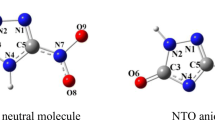Nateglinide (NAT) is an oral antihyperglycemic agent used for the treatment of noninsulin-dependent diabetes mellitus. We evaluated the NAT stability under various forced degradation tests (acidic, basic) and predicted the degradation mechanism of the NAT molecule in the gaseous phase and aqueous media. A first-order derivative spectrophotometric method was used for the identification of NAT and the products of its degradation. NAT appeared to be stable in acidic but not in basic media. A probable reaction path of the NAT molecule with OH radicals was analyzed. The optimized geometry was calculated with Gauss View 5. Subsequently, the lowest energy status was determined through geometric optimization using Gaussian 09 software. Aiming to determine the intermediates in the photocatalytic degradation mechanism, the geometric optimization of the molecule was realized using the density functional theory method. The activation energy for the probable reaction path was calculated, and their most stable state from the thermodynamic perspective was determined for the gaseous phase and aqueous media. The predicted mechanism was confirmed by comparison with the experimental results on simple structures reported in the literature.
Similar content being viewed by others
References
The Merck Index, 13th ed., Nateglinide, Merck, Inc., Whitehouse Station (2001).
C. J. Dunn and D. Faulds, Drugs, 60, 607–617 (2000).
WHO, https://www.who.int/health-topics/diabetes, accessed 07.02.2020.
A. B. Thomas, S. D. Patil, R. K. Nanda, L. P. Kothapalli, S. S. Bhosle, and A. D. Deshpande, Saudi Pharm. J., 19, No. 4, 221–231 (2011).
A. Rastogi, K. Jha Kishore, V. Verma, J. Singh, and J. Sagar, Pharma Res., 1, 169 (2009).
M. Sireesha, R. S. Chandan, B. M. Gurupadayya, and A. Shravya, Pharma Chem., 3, 497–506 (2011).
D. E. Han, Y. Zheng, N. Li, D. Zhao, G. Zhang, H. Yan, L. Zhang, W. Sun, Y. N. Wu, Y. Lu, and X. Chen, Chromatographia, 71, 299–304 (2010).
C. B. Ojeda and F. S. Rojas, Anal. Chim. Acta, 518, 1–24 (2004).
F. S. Rojas, C. B. Ojeda, and J. M. Pavon, Talanta, 35, 753–761 (1988).
J. Karpińska, Talanta, 64, 801–822 (2004).
A. A. Shirkhedkar, H. C. Bhirud, and J. S. Surana, Pak. J. Pharm. Sci., 22, 27–29 (2009).
C. Jenee, S. Purvi, P. Margi, P. Kalpana, and G. Tejal, J. Taibah Univ. Sci., 11, 729–740 (2017).
A. S. Dimal, J. S. Dixita, N. D. Chirag, K. C. Usman, and K. B. Kashyap, Arab. J. Chem., 10, 105–108 (2017).
International Conference on Harmonization. ICH. Validation of analytical procedures: text and methodology Q2 R1 (2005).
International Conference on Harmonization, ICH. Stability testing of new drug substances and products Q1A R2 (2003).
V. G. Buxton, L. C. Greenstock, P. W. Helman, and B. A. Ross, J. Phys. Chem., 17, 513–886 (1988).
M. Anbar and P. Neta, Int. J. Appl. Radiat. Isot., 18, 495–523 (1965).
B. Halliwell, M. Grootveld, and J. M. C. Gutteridge, Methods Biochem. Anal., 33, 59–90 (2006).
A. Hatipoglu, D. Vione, Y. Yalcin, C. Minero, and Z. Cinar, J. Photochem. Photobiol. A: Chem., 215, 59–68 (2010).
P. W. Atkins, Physical Chemistry, 6th ed., Oxford University Press, New York (1998).
K. K. Mierzejewska, J. Trylska, and J. Sadlej, J. Mol. Model., 18, 2727–2740 (2012).
Gaussian 09, Revision B.04, Gaussian, Inc., Pittsburgh, PA (2009).
D. B. Pathare, A. S. Jadhav, and M. S. Shingare, Drug Dev. Ind. Pharm., 33, No. 5, 551–557 (2007).
Asha Byju Thomas, Shrikrushn, Digambar Patil, Rabindra Kumar Nanda, Lata Prasad Kothapalli, Shital Shridhar Bhosle, and Avinash Devidas Deshpande, Saudi Pharm. J., 19, No. 4, 221–231 (2011).
K. Basavaiah and N. Rajendraprasad, Austin J. Anal. Pharm. Chem., 5, No. 1, 1096 (2018).
A. Karasakal and E. Ozdemir, J. Res. Pharm., 23, No. 3, 457–464 (2019).
Author information
Authors and Affiliations
Corresponding author
Additional information
Published in Zhurnal Prikladnoi Spektroskopii, Vol. 88, No. 6, pp. 914–919, November–December, 2021.
Rights and permissions
About this article
Cite this article
Karasakal, A., Gürkan, Y.Y. Forced Degradation Studies of Nateglinide by the First-Order Derivative Spectrophotometric Method and the Density Functional Theory of the Nateglinide Molecule. J Appl Spectrosc 88, 1183–1188 (2022). https://doi.org/10.1007/s10812-022-01297-6
Received:
Published:
Issue Date:
DOI: https://doi.org/10.1007/s10812-022-01297-6




